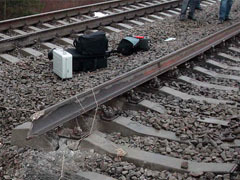
The Separation of the North Caucasus from Russia: Is it A Growing Possibility?
Publication: Eurasia Daily Monitor Volume: 8 Issue: 38
By:

The new act of terror committed by suicide bombers in Dagestan on February 14 appears to have been a continuation of a series of attacks across Russia carried out by the North Caucasus armed resistance movement, which over the years has become increasingly capable of striking across the entire country.
On the evening of February 14, Valentine’s Day, a suicide bomber trying to get inside a police station in the Dagestani village of Gubden was stopped at a barrier outside the building. Asked by security officers to provide identification documents, the female suicide bomber detonated an explosive device, killing one person and wounding four others (www.rosbalt.ru/2011/02/14/819292.html). While that seemed like the end of the story, that same evening another explosion occurred at the same police station, this time killing one officer and injuring 22 others. A male bomber apparently drove up to the same police station in a Lada Priora automobile at around 11:35 p.m., local time, exactly two hours after the first blast. By that time, a few investigators had already started to probe the first explosion. The Russian Internet newspaper Gazeta.ru reported that a policeman stopped the vehicle for a document check and that an explosive device was detonated as soon as he approached the car. In total, two police officers were killed and 26 injured in the tragic events of that deadly Valentine’s Day evening (www.kavkaz-uzel.ru/articles/181061/).
The village of Gubden, located in Dagestan’s Karabudakhkent district, is by far the most famous and, arguably, the most troubled village in that Russian republic. Populated by ethnic Dargins, one of the multiethnic republic’s indigenous peoples, Gubden is one of the oldest and richest villages in Dagestan. According to some accounts, Gubden is 5,000 years old and currently has more than 35,000 inhabitants. However, it is commonly known today as a village where security forces incessantly conduct special operations against the leaders of the armed underground. Magomedali Vagabov, the leader of Dagestan’s Sharia Jamaat who was killed last summer, also came from this village. It is completely wrong when journalists present Gubden as a stronghold of Salafism in Dagestan. There are, of course, some followers of Salafism in Gubden, as in other villages, but most of the population there are Tariqas. Incidentally, it was as the result of a standoff between proponents of Salafism and Sufism that Nurmuhammad Gadzhimagomedov, the imam of the village, was killed (www.assalam.ru/assalam07/296/02-s.shtml).
It is worth noting that according to Kavkazsky Uzel, the website covering developments in the Caucasus, 22 terrorist acts were perpetrated in Moscow and the North Caucasus in 2010, in which 108 people were killed and more than 652 injured. Out of those 22 attacks, 16 were carried out by suicide bombers, including six bombings on the territory of Dagestan.
Meanwhile, Chechen authorities are growing worried about the image that they themselves created. After admitting the bombing these officials then tried to disprove a series of strange explosions that occurred in Chechnya’s capital Grozny were actually bombings (www.prime-tass.ru/news/0/%7BB8E24515-4BFA-457F-9EB2-A96C4EAEA9BA%7D.uif). All the explosions were declared to have been accidental natural gas explosions in residential buildings. After one of the explosions, Chechnya’s pro-Russian leader Ramzan Kadyrov personally tried to demonstrate at the scene of the blast that it was too small to have been the result of a bomb or grenade (www.prime-tass.ru/news/0/%7B88C8A268-4387-403E-9AE8-C4C6AC6EFACC%7D.uif).
Unexplained is why those explosions affected mainly security forces: the blasts injured four police officers but only one civilian. The explosions still could have been viewed as accidental had not a troubling series of events occurred concurrently in southern Chechnya. On Kadyrov’s orders, a large-scale special operation began in that area on February 8 against members of the armed underground following attacks on a Chechen police outpost in the vicinity of the mountainous village of Kharsenoi in the Shatoi district and on a Russian Internal Troops’ military helicopter at the juncture of the Shatoi and Urus-Martan districts on February 7. An alleged militant was killed during the special operation on February 10. The rebels in area are led by Tarkhan Gaziev, one of the Chechen rebel leaders who, together with two other leading Chechen commanders, Aslanbek Vadalov and Hussein Gakaev, recently renounced their oaths of loyalty to Doku Umarov, the “emir” of the Caucasus Emirate.
Moreover, the decision taken on February 10 to terminate all rail transport on the territory of Chechnya and Dagestan from 6:00 p.m. to 6:00 a.m. is additional proof that the situation in the region can hardly be characterized as calm (https://www.rian.ru/society/20110210/332925470.html). A similar regulation was in effect in Chechnya during the fierce fighting that occurred there in 1999-2002. Almost ten years later, the Russian leadership has had to admit that it has gone back to measures that first were introduced in the region by Vladimir Putin, the then Russian president, at the beginning of the second Russo-Chechen war. This decision was a further response to the numerous train bombings perpetrated by militants throughout Dagestan for most of last year, including the reintroduction of Russian armored trains (https://www.jamestown.org/programs/edm/single/?tx_ttnews[tt_news]=36077&tx_ttnews[backPid]=27&cHash=479b23f64f). The newly enacted measure will affect rail connections not only between Dagestan and Chechnya, but to and from Azerbaijan as well.
Meanwhile, the situation remains particularly tense in Ingushetia and Kabardino-Balkaria. For instance, on the evening of February 12 law enforcement officers attempted to stop a suspicious car in the Ingush town of Nazran, but unidentified men driving in the car opened fire on them. Two men in the car were killed and were later declared to be “possible perpetrators” of the murder of the head of one of Nazran’s districts, Alikhan Tsoroev (www.kavkaz-uzel.ru/articles/180963/). The next day a retired police colonel was attacked and a local resident, A. Kostoev, was killed in downtown Nazran. Also, there are continuous reports of young men being abducted by undisclosed entities, making the situation in this tiny republic extremely tense.
In neighboring Kabardino-Balkaria, the Russian president’s envoy to the North Caucasus Federal District, Aleksandr Khloponin, held meetings with local residents, students and the republic’s leadership in an attempt to reduce tensions there. Khloponin cited four reasons contributing to the unfavorable situation in the region: the malfunctioning of the authorities at all levels of the power vertical, as well as corruption; crime; a lack of understanding of the essence of Islam; and unemployment and other economic factors (https://www.kavkaz-uzel.ru/articles/180805/). What is missing in Khloponin’s list is the main reason for instability in the region –growing separatism, which is the result not of the four factors Khloponin mentioned, but of the very essence of the Kremlin’s policy in the Caucasus.
Against this background, it is hard not to notice that there has been some discussion of the possibility of the Northern Caucasus seceding from the Russian Federation, although few so far believe it is likely. But, unlike the earlier period, when only chauvinistic Russian leaders like Vladimir Zhirinovsky and the like talked about this possibility, today the discussion is gradually turning into a mainstream exchange of views, which is encouraging (https://www.rosbalt.ru/2011/02/11/818443.html). The fact that such a discussion is even taking place and that there is the desire to even discuss this option in some Russian circles –as long as it is not soon cut off by the authorities– raises the possibility of a future in which there are not warring camps, but the possibility of two peacefully coexisting countries.




